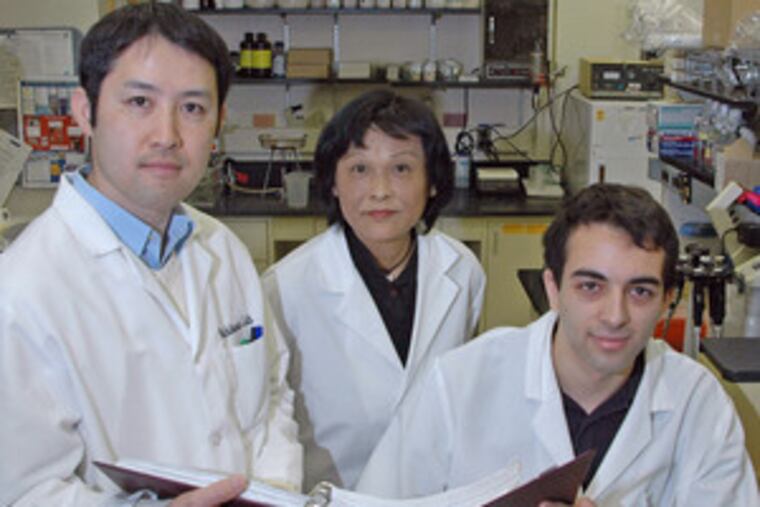What separates us from the worms
When scientists first started cracking open the code of life, they were puzzled that humans didn't have that many more genes than "lower" animals such as worms and flies.

When scientists first started cracking open the code of life, they were puzzled that humans didn't have that many more genes than "lower" animals such as worms and flies.
Part of the reason, it turns out, is that people have good editors: enzymes that trim here and replace there, temporarily altering our genetic instructions in numerous ways so that one gene can have the impact of many.
A new paper by Philadelphia scientists - including a 19-year-old graduate of Central High School who moved here from Belarus in 1989 - provides fresh insight on one aspect of this molecular marvel.
In today's issue of the journal Science, they describe for the first time how changing a single molecular base in a tiny snippet of ribonucleic acid (micro RNA) could play a vital role in human health. Working with mice, the team showed that a breakdown in this process of RNA editing leads to high levels of uric acid - a substance that can lead to gout or neuron damage in humans.
The team's paper "is a milestone," said Lehigh University biologist Stefan Maas, an expert in RNA editing who was not involved with the research.
RNA editing is thought to be just one way that humans get more out of their 30,000 genes than, say, a fruit fly does with 13,600 or a roundworm does with 19,100. Those creatures have more primitive editing machinery, said the paper's senior author, Kazuko Nishikura of Philadelphia's Wistar Institute.
And they have much less of what is sometimes misleadingly called "junk" DNA - a region of the genome that does not produce proteins but nevertheless appears to play a key role in the diversity of life.
The new paper is one of numerous recent finds in the booming field of RNA research. In the early days of genetic study, RNA was seen basically as a messenger for its cousin, DNA, carrying instructions to direct the manufacture of proteins.
But other kinds of RNA have since been discovered, including some that regulate or turn off certain genes, playing a role in embryonic development and - when things go awry - in diseases such as cancer. Last year's Nobel Prize in medicine was awarded to scientists who pioneered a related field called RNA interference.
And RNA is now thought to be even older than DNA, with some saying it served as the genetic blueprint for the earliest forms of life.
The lead authors of the new paper are postdoctoral researcher Yukio Kawahara and University of Pennsylvania sophomore Boris Zinshteyn (the 19-year-old). Both work under Nishikura's supervision at Wistar, an independent research institute on the Penn campus.
Other authors are Wistar's Hisashi Iizasa and Penn's Praveen Sethupathy and Artemis Hatzigeorgiou, who used computers to probe the genome to predict sites where micro RNA could do its regulatory work.
There are several ways in which RNA can be edited, resulting in the manufacture of many thousands more kinds of proteins than might otherwise be the case.
In one type of editing, enzymes can alter the familiar messenger RNA in a variety of ways so that one gene can have the impact of 24. Failures in this type of editing have been linked to brain maladies such as epilepsy, depression and schizophrenia.
Another type of editing, the kind described in the new paper, involves alterations in micro RNA.
These snippets of RNA can suppress parts of the messages carried by messenger RNA, latching onto a matching site like a piece of a molecular puzzle.
"You can think about it like a brake for the car," said Nishikura, the senior author.
When micro RNA is edited, however, it acts as a brake on a different car - that is, on different kinds of messenger RNA. Thus, different proteins will be suppressed.
These various kinds of editing do not affect the underlying genome, said Phillip Zamore, a professor of biomedical sciences at the University of Massachusetts Medical School.
"It's like writing on a photocopy," Zamore said. "You always have the original." He called the new research "intellectually exciting" but said much follow-up lies ahead.
Editing of micro RNA was first described by Lehigh's Maas, in 2004. Maas said the Wistar-Penn paper is the first to show that such editing has a physical consequence in a living creature.
The Penn computer analysis suggested that one particular kind of micro RNA had the ability to regulate 80 different human genes. So, in theory, the edited version of that micro RNA would regulate a completely different set of 80 genes.
The Wistar researchers randomly selected one of those genes - one involved in the production of uric acid - to test whether it was indeed affected by micro RNA editing.
They compared regular mice with mice that were genetically unable to edit this kind of micro RNA. Sure enough, the mice without the ability to edit had levels of uric acid that were twice as high as in normal mice.
Scientists believe that humans need some uric acid in their brains, but not too much. Nishikura said the level was probably balanced by several different mechanisms, including the editing she and her colleagues described.
Researchers say it is likely that many of our genes are not affected by micro RNA editing.
But Nishikura is sure that plenty are. Her team already is trying to find the next one.
Counting Genes
The number of genes found on an organism's chromosomes has little to do with its complexity.
Species Genes* Chrom.
Human 30,000 46
Rat 30,000 42
Mouse 30,000 40
Fruit fly 13,600 8
Thale cress
plant 25,500 10
Roundworm 19,100 12
Yeast 6,300 32
E. coli 3,200 1
* Estimated
SOURCE: Human Genome Project
EndText